
The Diocese of Nola is a Latin diocese of the Catholic Church in Italy, suffragan of the Archdiocese of Naples. Its seat is the Campanian city of Nola, now a suburb of Naples. Its cathedral is dedicated to the Assumption. The dedication was originally to S. Stephen, the Protomartyr, but after the second reconstruction the dedication was changed to the Assumption. It is traditionally credited with the introduction of the use of bells into Christian worship.

The Roman Catholic Diocese of Ferentino existed until 1986, when it was united into the new diocese of Frosinone-Veroli-Ferentino.
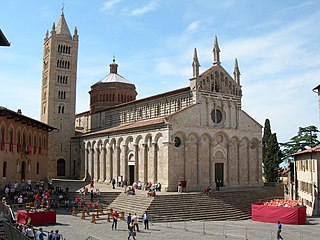
The Diocese of Massa Marittima-Piombino is a Latin Church diocese of the Catholic Church in Tuscany, central Italy. It was known as Diocese of Massa Marittima before 1978. Up until 1458, it was a suffragan of the archdiocese of Pisa; since 1458, it has been a suffragan of the Archdiocese of Siena. The territory of the diocese includes the islands of Elba and Pianosa, and Capraia.

The Archdiocese of Lecce is a Latin Church ecclesiastical territory or archdiocese of the Catholic Church in Apulia, southern Italy. The diocese has existed since the 11th century. On 28 September 1960, in the bull Cum a nobis, Pope John XXIII separated the diocese of Lecce from the ecclesiastical province of Otranto and made it directly subject to the Holy See. In the bull Conferentia Episcopalis Apuliae issued on 20 October 1980, Pope John Paul II created the ecclesiastical province of Lecce, with the Archdiocese of Otranto becoming a suffragan diocese.

The Archdiocese of Pescara-Penne is a Latin diocese of the Catholic Church on the east coast in central Italy.

The Diocese of Isernia-Venafro is a Latin Church diocese of the Catholic Church in Molise. It is a suffragan of the archdiocese of Campobasso-Boiano. In 1852 the historic diocese of Isernia was combined with the diocese of Venafro, to form the diocese of Isernia e Venafro. The seat of the present bishop is Isernia Cathedral, while Venafro Cathedral has become a co-cathedral in the new diocese.
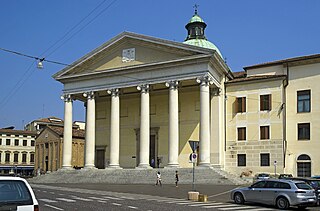
The Diocese of Treviso is Latin Church ecclesiastical territory or diocese of the Catholic Church in the Veneto, Italy. It is a suffragan diocese in the ecclesiastical province of the metropolitan Patriarchate of Venice.
The Catholic diocese of Sarsina was a Roman Catholic ecclesiastical territory in Emilia-Romagna, northern Italy, seated in Sarsina, in the province of Forlì, some 32 km south-southwest of Cesena. The diocese was founded in the 5th century, and was suffragan (subordinate) to the archbishop of Ravenna. The diocese existed until 1986, when it was united with the diocese of Cesena.

The Diocese of Ascoli Piceno is a Latin diocese of the Catholic Church in the Marche. It has existed since the fourth century. Historically immediately dependent on the Holy See, it is now a suffragan of the Archdiocese of Fermo. There is, in 2015, one priest for every 1,074 Catholics.
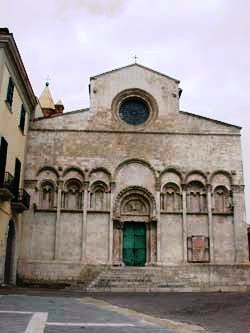
The Diocese of Termoli-Larino is a Latin Church diocese of the Catholic Church situated in the province of Campobasso, region of Molise. The commune of Termoli is an important regional seaport. The diocese has existed in its current configuration since 1986, when the diocese of Larino was suppressed and added to its territory. It is a suffragan of the archdiocese of Campobasso-Boiano.

The Diocese of San Severo is a Latin diocese of the Catholic Church in Apulia. It is a suffragan of the Archdiocese of Foggia-Bovino.
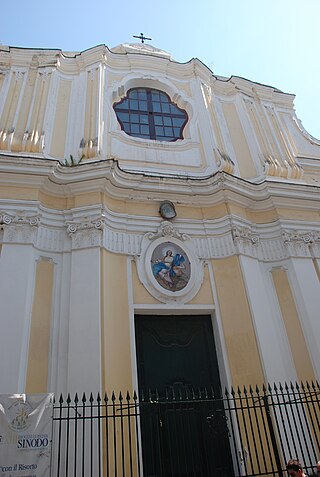
The Diocese of Ischia is a Latin diocese of the Catholic Church in Campania, southern Italy. It is a suffragan of the Archdiocese of Naples. The diocese comprises the entire island of Ischia, which contains seven communes divided into two circumscriptions. In 1743, the population was about 4,000. The city of Ischia constituted one single parish, with two religious houses of men and one of women. In 2018, the population of the town of Ischia was 20,118.

The Diocese of Pozzuoli is a Latin diocese of the Catholic Church in Campania, southern Italy. It is a suffragan of the Metropolitan Roman Catholic Archdiocese of Naples, like its other neighboring dioceses, Aversa and Ischia.

The Diocese of Caserta is a Latin diocese of the Catholic Church in Campania, southern Italy. It is a suffragan of the Archdiocese of Naples. In 1818 Pope Pius VII united this see with the diocese of Caiazzo, but Pope Pius IX made them separate sees. In 2013 in the diocese of Caserta there was one priest for every 1,703 Catholics; in 2016, there was one priest for every 2,008 Catholics. The diocesan Major Seminary currently (2019) has four seminarians.
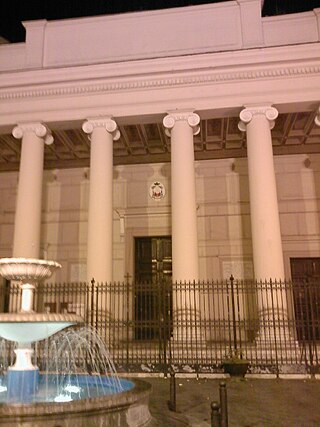
The Diocese of Acerra is a Latin diocese of the Catholic Church in Campania, southern Italy, eight miles east of Naples, in the area once called Terra Laboris (Liburia). It has existed since the 11th century. It is a suffragan of the Archdiocese of Naples.

The Diocese of Sessa Aurunca is a Latin diocese of the Catholic Church in southern Italy. Since 1979 it has been a suffragan of the Archdiocese of Naples.

The Diocese of Anagni-Alatri is a Latin Church ecclesiastical territory or diocese of the Catholic Church in Lazio, Italy. It has existed in its current form since 1986. In that year the Diocese of Alatri was united to the historical Diocese of Anagni. The diocese is immediately exempt to the Holy See.

The Diocese of Castellaneta is a Latin diocese of the Catholic Church in Apulia. It is a suffragan of the Roman Catholic Archdiocese of Taranto.
The Italian Catholic diocese of Lacedonia, a suffragan of the archdiocese of Benevento in Campania, existed until 1986 when incorporated into the reorganized Roman Catholic Diocese of Ariano Irpino-Lacedonia.

The Diocese of Guardialfiera or Diocese of Guardia was a Roman Catholic diocese in Italy. The diocese was established in the second half of the 11th century, with seat of the diocese was located in the city of Guardialfiera in the Province of Campobasso in the region of Molise. In 1818, the diocese was suppressed, and its ecclesiastical territory was assigned to the Diocese of Termoli.




















